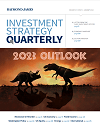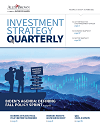What can investors expect this year? A mild recession, fixed income strength and emerging market growth, says Raymond James CIO Larry Adam.
To read the full article, see the Investment Strategy Quarterly publication linked below.
Steven Spielberg’s sci-fi thriller Jurassic Park celebrates its 30th anniversary this year. To articulate our outlook for 2023, we focus on the theme of evolution: the ebb and flow, contraction and expansion that breeds stronger economies and financial markets over time.
1. Months in the making: A mild recession
Economists, CEOs, consumers and the media have been ringing the recession alarm for months. It might be the most telegraphed recession in history. Our base case is that the economy will experience a mild recession this year. Because of aggressive tightening from the Federal Reserve (the Fed), there’s already a power outage in areas such as housing, transportation, some retail, and even parts of tech. Strong consumer fundamentals (e.g., excess savings, job openings) are acting as a buffer. Still, dwindling savings and weakening labor market conditions will stall the momentum of the economy by midyear.
2. Fed is the predator, inflation the prey, but the hunt ends soon
The Fed’s 425 basis point squeeze has been the most aggressive tightening since 1980. With the policy cutting into demand, inflation won’t be at the top of the market-risk food chain for much longer. Prices for commodities, goods, and services have already started to falter, and the pressures on food and shelter costs should ease in the months ahead. But although the Fed is battling inflation, a weakening labor market, and excessive speculation, that does not mean it has the appetite for rate cuts just yet. After pushing rates to an ~5% peak, the Fed is more likely to pause the pursuit than pivot by year end.
3. Reduced volatility ahead
Between a pandemic, a war, economic troubles in China, inflation and the risk of a recession, it’s no wonder the S&P 500 saw the most 1% swings since 2008 and the 60/40 portfolio had its most volatile year since 1987. But the worst-case scenario for many risks has already been priced in. The Russia-Ukraine war is no longer a daily front page story, the midterm elections are behind us, and China appears set to dismantle its zero-COVID policy. Therefore, it’s likely that some positive developments will put volatility back in its cage in 2023.
4. Globalization is evolving, not ending
The supply chain disruptions throughout the worst of the pandemic had some market pundits trumpeting that a multi-national approach to business would soon be extinct. But we’d counter that globalization isn’t ending but evolving. The competitive advantages are still intact: cost and production efficiencies, scalability and workforce growth, to name a few. And as a result, our bias for large domestic multi-national companies is heightened. U.S. brands are leading across the globe, and U.S. companies with niche marketing outside the U.S. are experiencing superior earnings growth.
5. Seeking safety and security
After the last three bruising years, enhanced security will be at the forefront of 2023 and beyond. Governments, companies, and investors have learned painful lessons. Look for carbon-based security, like protecting oil and natural gas sourcing following the fallout with Russia. Or shifting the most critical supply chains, such as semiconductors and healthcare products, back to domestic sources. Or protecting power and internet grids from hackers. And, of course, replenishing U.S. (and its allies’) military capabilities will be a top priority.
6. Fixed income feast
Fixed income investors are ready to feast on the higher rates they haven’t had in years. Although rates seem to have reached their peak, yields are still attractive. And there’s less risk. In fact, investors can obtain nearly as much yield on a 3-month Treasury bill today as they could on a high yield bond at the beginning of 2022. Over the course of the year, economic struggles and easing inflation will lead to a lower 10-year Treasury yield (year-end forecast: 3%). With many subsets of the yield curve inverted, investors should opt for quality over chasing more income from riskier high yield bonds.
7. Equities not on the rocks
With the heightened probability of a recession, some speculate that equities are headed for another rocky year. However, the equity market is a forward-looking indicator. P/Es tend to expand as interest rates fall, and the S&P 500 hasn’t notched three consecutive years of P/E contraction since at least 1994. The consensus outlook for earnings growth has been lackluster. However, if 2022 was about businesses having pricing power, 2023 will be the year of cost cutting. As companies enter preservation mode, margins will hold and, in turn, earnings will be better than previously believed. CEOs will also not turn to stone, and the shareholder-friendly activities of recent years (e.g., dividend growth, buybacks) won’t cease to exist. As a result, our year-end forecast for the S&P 500 is ~4,400.
8. Digging into emerging markets
Between the stronger dollar, Fed tightening and weaker global growth, it’s been hard to uncover emerging market opportunities. But now, the headwinds that buried most emerging market regions underground have become tailwinds pushing them to the surface. Emerging market growth is expected to outpace that of the developed market by the widest margin since 2013.
9. Don’t touch the hot spots
We caution most investors from speculative hot spots (e.g., meme stocks). 2023 will foster a survival of the fittest environment, and even though our expectation is for modest positive returns in the aggregate, natural selection will run its course beneath the surface. Sometimes you need to focus on the basics and let the fundamentals lead your portfolio decisions. Active money managers could have mammoth opportunities to outperform, given regional, sector, industry and even company-specific dispersion.
10. Discover attractive alternatives
As 2023 begins, Wall Street strategists are calling for a much weaker year than we’ve historically seen. But investors shouldn’t blindly follow with a herd mentality. In 2023, some of the best opportunities may require moving in isolation (contrarian). For example, REITs in the aggregate have sharply turned out of favor. But valuations are attractive, and for specific industries within the sector (e.g., cell towers, healthcare facilities), earnings should be less sensitive to the downturn. The Technology sector should also not be cast aside, as the more diversified or multi-faceted companies still display strong fundamentals.
Life, the markets and investors will find a way
Incessant gloom-and-doom headlines may make investors feel as though 2023 will be a lost year for the economy and the markets. True, the oncoming recession isn’t in the rear-view mirror yet. Yet adapting to the times and working to discover opportunities has usually proven more successful than acting on fear or emotions. Your financial advisor can help guide you through the year ahead and the ever-changing investment landscape.

Read the full
Investment Strategy Quarterly
Read the full
Investment Strategy Quarterly
All expressions of opinion reflect the judgment of the Chief Investment Office, and are subject to change. This information should not be construed as a recommendation. The foregoing content is subject to change at any time without notice. Content provided herein is for informational purposes only. There is no guarantee that these statements, opinions or forecasts provided herein will prove to be correct. Past performance may not be indicative of future results. Asset allocation and diversification do not guarantee a profit nor protect against loss. The S&P 500 is an unmanaged index of 500 widely held stocks that is generally considered representative of the U.S. stock market. Keep in mind that individuals cannot invest directly in any index, and index performance does not include transaction costs or other fees, which will affect actual investment performance. Individual investor’s results will vary. Investing in small cap stocks generally involves greater risks, and therefore, may not be appropriate for every investor. International investing involves special risks, including currency fluctuations, differing financial accounting standards, and possible political and economic volatility. Investing in emerging markets can be riskier than investing in well-established foreign markets. Investing in the energy sector involves special risks, including the potential adverse effects of state and federal regulation and may not be suitable for all investors. There is an inverse relationship between interest rate movements and fixed income prices. Generally, when interest rates rise, fixed income prices fall and when interest rates fall, fixed income prices rise. If bonds are sold prior to maturity, the proceeds may be more or less than original cost. A credit rating of a security is not a recommendation to buy, sell or hold securities and may be subject to review, revisions, suspension, reduction or withdrawal at any time by the assigning rating agency. Investing in REITs can be subject to declines in the value of real estate. Economic conditions, property taxes, tax laws and interest rates all present potential risks to real estate investments. The companies engaged in business related to a specific sector are subject to fierce competition and their products and services may be subject to rapid obsolescence.
Markets & Investing April 01, 2024 Market rally driven by a broadening of the market and optimism that...
Markets & Investing April 01, 2024 Raymond James CIO Larry Adam reminds investors they need to be well...
Markets & Investing April 01, 2024 Doug Drabik discusses fixed income market conditions and offers...
